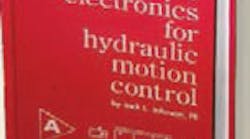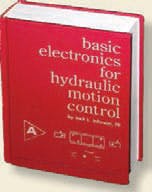Editor's note: This is the sixth installment in a seven-part series on digital resolution and other subjects. Read the rest now: Part 1, Part 2, Part 3, Part 4, Part 5, and Part 7.
The incremental optical encoder (discussed in the December 2010 issue) senses rotation and direction using two optical channels — the in phase and the quadrature — which produce pulse trains that are 90° out of phase with each other. The construction produces a great number of pulses per revolution, giving extremely good resolution (up to 10,000 counts per revolution), and both phases are available to the user. Some configurations have logic circuits to provide a high resolution pulse train on one wire and the sense bit on another. The sense bit is set to a one logic level for one direction of rotation and to a zero logic level for the other.
Integrated speed sensing
One of the first questions a pump or motor designer must ask why do we even need on-board speed sensing at all. It may be that a pump speed sensor should really be associated with the prime mover. Certainly in engine driven mobile equipment, there is a speed control system that regulates output speed. If so, what is the value of speed sensor on the pump, because the engine’s sensor would provide the same information? As long as the engine and pump shafts are hard connected, then the pump’s sensors would be redundant.
The question of where the speed sensor should be located for industrial applications is more open. Should it be on the prime mover shaft, or should it be on the pump? The answer can be facilitated with the proper coordination of the several standards-writing bodies that are affected by and which affect the electric vs. hydraulic power transmission realms.
A second important issue about speed sensing has to do with the need to sense speeds in both directions. In most applications, pumps are not operated under bidirectional shaft rotations, especially in engine driven equipment. Therefore, this immediate discussion is more of a general statement regarding rotational speed measurement. However, some applications use a dc motor to power a bidirectional pump for changing both the direction and rate of flow to an actuator by controlling the electric motor’s rotational direction and speed, respectively.
Frequency generation methods for speed sensing are problematic in such applications because they do not inherently provide direction of rotation information. If bidirectional operation is required, then frequency generation devices are equipped with two output channels. They are labelled A and B on encoders and called the in-phase and the quadrature channels, respectively.
The two frequency signals are 90° out of phase with each other at all speeds, and with accompanying logic modules, a comparison of the two channels can generate a third signal, digital in nature, called the direction bit. For example, when the shaft is rotating clockwise, the bit is set to a one logic level; when rotating counterclockwise, the bit is set to a zero logic level. Therefore, the detecting circuits — such as a motion controller or controlling computer — only have to look at the direction bit to determine the direction of rotation.
Another issue regarding the frequency method of measuring speed is that signal-counting circuitry must accept pulses at the required frequencies and process the accumulated digits into something the computer interface can interpret. This circuitry must be mounted somewhere, either in the control computer interface or within the sensor’s signal conditioning electronics. Again, the counter content represents the value of the speed, and the direction bit is used by the computer to attach a negative sign or not.
Making compromises
Interest so far has focused on the need to achieve the best resolution — the greatest number of significant digits in the measured speed readout. The error in speed measurement (or any measurement) can never be less than the resolution, making obvious the need for high resolution. The control system also benefits from minimization of measurement errors. However, there is also a need for the shortest possible time delay. It bears repeating: speed measurement that relies on frequency measurement always results in a significant time delay that can be devastating to the control system.
Improved resolution operates to increase the time delay. For example, we have seen how a 10-sec gate time adds one significant digit over a 1-sec gate. However, except for the very slowest moving electrohydraulic systems, a delay of 10 sec would render the machine quite worthless. The system designer must always be seeking the best compromise between resolution and minimal time delay.
When using digital frequency methods, the computer signals the counter that it is ready for speed data, then initiates the counter function. After the counter gate time has passed, the data is ready, but not before. Sampling the counter before it has completed its accumulation process would result in significant error. Hence, the computer always receives speed data that is old. In the limiting cases, the speed data is so old that by the time the correcting action takes place, the amount of correction is based on data that is too old.
The result can be oscillation in the control loop that uses the speed information because over-correction occurs. Neophytes often think they can “trick” the system into nullifying the time delay error, by starting the sampling earlier than it is needed. Unfortunately, such schemes only trick the designer because the time delay always exists. To eliminate time delay errors, other speed measurement technology must be employed.
Period measurement
One concern already discussed is that of the data being old by the time it is accumulated in the counter. Another concern is that the frequency measurement method always leads to an average (mean) value, which may or may not be desirable, depending on circumstances. Another concern is the problem with data display resolution. As discussed previously, when using frequency to measure speed, as the speed becomes slower and slower, the number of significant digits diminishes unless the gate time is commensurately increased.
Switching from frequency measurement to a period measurement process can circumvent these problems. Whereas frequency measurement produces cycles per unit of time (measured as Hz), period measurement yields seconds per cycle. The time between pulses is measured by taking advantage of the clock associated with electronic counters and other digital devices, such as computers.
In the case of normal frequency measurement, the frequency to be counted is that which comes from an encoder or magnetic pickup, and the gate time is generated by the electronic counter. When measuring period, however, the signal roles are somewhat reversed. The frequency to be counted is taken from the electronic counter clock, often faster than 1 MHz. The gate is then established as that time between successive pulses of the unknown signal. The result is that the counter display will contain the number of seconds that were expended between successive pulses of the unknown signal.
Clearly, more accurate speed measurements can be made when a decision is made to switch from frequency to period measurement at a critical point. To keep resolution at its optimum value, it should be obvious that the two displayed values must be the same. Furthermore, it is almost always desirable to obtain the greatest number of significant digits because more significant digits improve resolution. The system designer can select to measure either frequency or period, which ever yields the greater number of significant digits.
Exploring dc tachometers
Another common method of measuring rotational speed is with a dc tachometer. The dc tachometer works like a low-power generator — the faster its rotational speed, the greater its output voltage. There are two major advantages in using dc tachometers. First, the dc tachometer inherently distinguishes direction of rotation by changing the algebraic sign of its output voltage. Second, it puts out a high level signal over most shaft speed ranges as they apply to use with hydraulic pumps and motors. This feature eliminates the need for external amplification. For example, an output voltage of, say, 1 V/1000 rpm is easily achievable.
A third possible advantage exists if all other transducers in the system will produce analog outputs. Such a decision means that the basic interface with the control computer will be made via a generalpurpose analog-to-digital converter (A/D). Digital interfaces will not be necessary.
On the other hand, dc tachometers make use of commutators and brushes to couple the rotating inside world to the stationary outside world. Brushes wear with continued use, leading to electronic noise and, eventually, to failure.
Tachometers also produce a certain amount of ripple voltage, the frequency of which is synchronous with the shaft speed. The ripple voltage is perfectly analogous to the pressure ripple that positive-displacement pumps and motors produce. The tachometer’s brush-commutator ripple can be problematic in closed-loop control systems. That is, as the speed approaches zero, the ripple frequency becomes lower and eventually reaches a frequency where the control system attempts to follow it.
Filtering these frequencies is also problematic. If the controlled component is a pump operating at a nominally high fixed speed, the ripple frequency is usually so high that the control loop cannot follow it anyway. However, if the controlled element is a hydraulic motor that must be operated over a broad speed range, then the commutator noise frequency is likely to be low enough that the hydraulic system can try to follow it. A key parameter in a dc tachometer is the amount of commutator ripple it has.
Brushless dc tachometers
Brushless dc tachometers are really ac devices that operate internally at some carrier frequency, such as 400 Hz, 1000 Hz, or as high as 10 Khz. Unlike encoding frequency generators, the frequency of a brushless dc tachometer is constant. The amplitude of the output is the important variable, and modern tachometers are capable of speed-to-voltage nonlinearity performance of less than 1%.
The dc feature comes as a result of a special signal conditioning circuit called a phase sensitive demodulator. (This is the same type of signal conditioner used linear variable differential transformers.) Internal operation of the brushless dc tachometer is strictly as an ac machine. However, signal conditioning provides a dc output voltage that is directly proportional to the shaft input speed and sensitive to direction of rotation.
However, unlike the brush-type dc tachometer, which needs no external power (except that needed to rotate its shaft), the brushless dc tachometer requires external dc power for the electronic signal conditioning circuitry. The advantage of these tachometers is that their output is reasonably linear with input, they exhibit no physical contact between rotating and stationary parts that would otherwise wear, and they have essentially no ripple voltage. However, they are generally more expensive than their brush-type cousins.
Basic Electronics for Hydraulic Motion Control
This is where your basic electronic training starts. This book, unlike many others, is written specifically by a practitioner of the hydraulic art for engineers and technicians working in hydraulics, but it teaches you all you ever needed to know about electronics. Your personal understanding of hydraulics is your ticket to learning electronics with this book, which is filled with analogies to simplify the understanding of concepts.
Everything you wondered about and need is here: transducers, interfaces, signal conditioners, pulse width modulation, controllers, amplifiers, transistors, analog electronics, digital electronics, and much, much more. It is a must read and reference for anyone interested in certification in the exploding technology of electrohydraulics.
It uses your knowledge of fluid power to help you learn and understand electronics. Order your copy now and get the book that makes electronics fun and easy to learn.
Authored by Jack L. Johnson, P.E., edited by Hydraulics & Pneumatics, and published by Penton Media, the hard cover textbook (ISBN 0-932905-07-2) contains 438 pages and sells for $99.00, plus shipping and sales tax. Click here for more information on this and other books from the H&P Bookstore.


